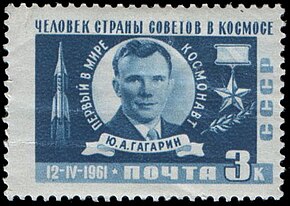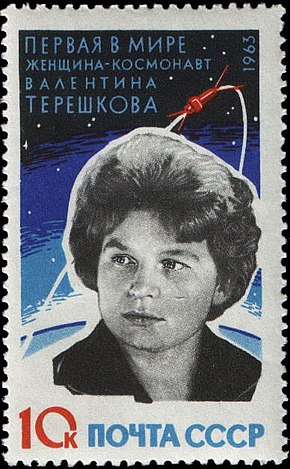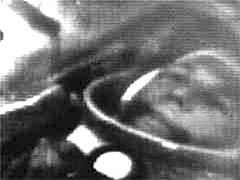
Vostok 1 was the first spaceflight of the Vostok programme and the first human orbital spaceflight in history. The Vostok 3KA space capsule was launched from Baikonur Cosmodrome on April 12, 1961, with Soviet cosmonaut Yuri Gagarin aboard, making him the first human to reach orbital velocity around the Earth and to complete a full orbit around the Earth.
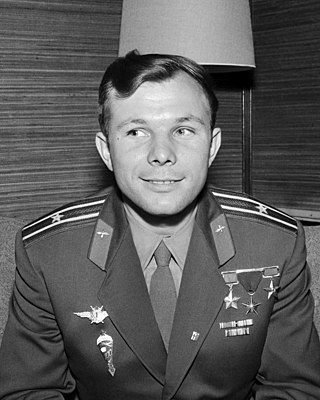
Yuri Alekseyevich Gagarin was a Soviet pilot and cosmonaut who became the first human to journey into outer space. Travelling in the Vostok 1 capsule, Gagarin completed one orbit of Earth on 12 April 1961. By achieving this major milestone in the Space Race he became an international celebrity, and was awarded many medals and titles, including Hero of the Soviet Union, his nation's highest honour.

A spacecraft is a vehicle or machine designed to fly in outer space. A type of artificial satellite, spacecraft are used for a variety of purposes, including communications, Earth observation, meteorology, navigation, space colonization, planetary exploration, and transportation of humans and cargo. All spacecraft except single-stage-to-orbit vehicles cannot get into space on their own, and require a launch vehicle.

The Space Race was a 20th-century competition between two Cold War rivals, the United States and the Soviet Union, to achieve superior spaceflight capability. It had its origins in the ballistic missile-based nuclear arms race between the two nations following World War II. The technological advantage demonstrated by spaceflight achievement was seen as necessary for national security, and became part of the symbolism and ideology of the time. The Space Race brought pioneering launches of artificial satellites, robotic space probes to the Moon, Venus, and Mars, and human spaceflight in low Earth orbit and ultimately to the Moon.
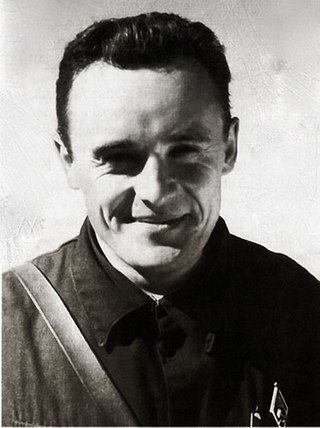
Sergei Pavlovich Korolev was a lead Russian rocket engineer and spacecraft designer during the Space Race between the United States and the Soviet Union in the 1950s and 1960s. He is regarded by many as the father of practical astronautics. He was involved in the development of the R-7 Rocket, Sputnik 1, launching Laika, Sputnik 3, the first human-made object to make contact with another celestial body, Belka and Strelka, the first human being, Yuri Gagarin, into space, Voskhod 1, and the first person, Alexei Leonov, to conduct a spacewalk.

Vostok 2 was a Soviet space mission which carried cosmonaut Gherman Titov into orbit for a full day on August 6, 1961, to study the effects of a more prolonged period of weightlessness on the human body. Titov orbited the Earth over 17 times, exceeding the single orbit of Yuri Gagarin on Vostok 1 − as well as the suborbital spaceflights of American astronauts Alan Shepard and Gus Grissom aboard their respective Mercury-Redstone 3 and 4 missions. Titov's number of orbits and flight time would not be surpassed by an American astronaut until Gordon Cooper's Mercury-Atlas 9 spaceflight in May 1963.
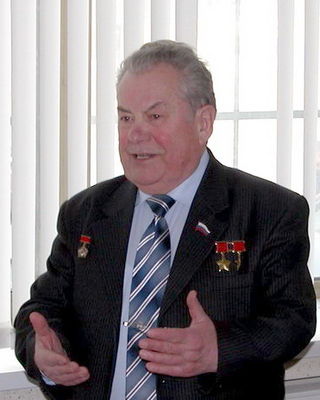
Pavel Romanovich Popovich was a Soviet cosmonaut.
Kosmos is a designation given to many satellites operated by the Soviet Union and subsequently Russia. Kosmos 1, the first spacecraft to be given a Kosmos designation, was launched on 16 March 1962.

The Vostok programme was a Soviet human spaceflight project to put the first Soviet citizens into low Earth orbit and return them safely. Competing with the United States Project Mercury, it succeeded in placing the first human into space, Yuri Gagarin, in a single orbit in Vostok 1 on April 12, 1961. The Vostok capsule was developed from the Zenit spy satellite project, and its launch vehicle was adapted from the existing R-7 Semyorka intercontinental ballistic missile (ICBM) design. The name "Vostok" was treated as classified information until Gagarin's flight was first publicly disclosed to the world press.
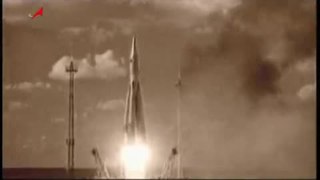
The Soviet space program was the national space program of the former Union of Soviet Socialist Republics (USSR), active from 1955 until the dissolution of the Soviet Union in 1991.

During the 1950s and 1960s the Soviet space program used dogs for sub-orbital and orbital space flights to determine whether human spaceflight was feasible. In this period, the Soviet Union launched missions with passenger slots for at least 57 dogs. The number of dogs in space is smaller, as some dogs flew more than once. Most survived; the few that died were lost mostly through technical failures, according to the parameters of the test. A notable exception is Laika, the first animal to be sent into orbit, whose death during the 3 November 1957 Sputnik 2 mission was expected from its outset.

Korabl-Sputnik 5 or Vostok-3KA No.2, also known as Sputnik 10 in the West, was a Soviet spacecraft which was launched in 1961, as part of the Vostok programme. It was the last test flight of the Vostok spacecraft design prior the first crewed flight, Vostok 1. It carried the mannequin Ivan Ivanovich, a dog named Zvezdochka, television cameras and scientific apparatus.

Cosmonautics Day is an anniversary celebrated in Russia and some other former Soviet Union countries on 12 April. In Poland an "International Day of Aviation and Cosmonautics" is celebrated on the same day. In 2011, at the 65th session of the United Nations General Assembly, 12 April was declared as the International Day of Human Space Flight in dedication of the first crewed space flight made on 12 April 1961 by the 27-year-old Russian Soviet cosmonaut Yuri Gagarin. Gagarin circled the Earth for 1 hour and 48 minutes aboard the Vostok 1 spacecraft.
The Lost Cosmonauts or Phantom Cosmonauts are subjects of a conspiracy theory alleging that some Soviet cosmonauts went to outer space, but their existence has never been publicly acknowledged by either the Soviet or Russian space authorities. Proponents of the Lost Cosmonauts theory argue that the Soviet Union attempted to launch human spaceflights before Yuri Gagarin's first spaceflight, and that cosmonauts onboard died in those attempts. Soviet military pilot Vladimir Ilyushin was alleged to have landed off course and been held by the Chinese government. The Government of the Soviet Union supposedly suppressed this information, to prevent bad publicity during the height of the Cold War.

Spaceflight began in the 20th century following theoretical and practical breakthroughs by Konstantin Tsiolkovsky, Robert H. Goddard, and Hermann Oberth. First successful large-scale rocket programs were initiated in the 1920s Germany by Fritz von Opel and Max Valier, and eventually in Nazi Germany by Wernher von Braun. The Soviet Union took the lead in the post-war Space Race, launching the first satellite, the first man and the first woman into orbit. The United States caught up with, and then passed, their Soviet rivals during the mid-1960s, landing the first men on the Moon in 1969. In the same period, France, the United Kingdom, Japan and China were concurrently developing more limited launch capabilities.

The RKK Energiya museum is a museum dedicated to the early achievements of Russian space exploration programmes. It is located on the grounds of the RKK Energiya factory in Korolyov, near Moscow. The date of the company founding is considered on August 26, 1946, when with the order of Dmitriy Ustinov as part of the Special Design Bureau of the NII-88 was formed, department No. 3 for the design of long-range missiles. Sergey Pavlovich Korolev was appointed chief designer department of 130 people. It was this department in 1951 that was transformed into OKB-1 - now RKK Energia. Since 1991, the corporation has the name of the chief designer Korolev.
With the advent of robotic and human spaceflight a new era of American history had presented itself. Keeping with the tradition of honoring the country's history on U.S. postage stamps, the U.S. Post Office began commemorating the various events with its commemorative postage stamp issues. The first U.S. Postage issue to depict a U.S. space vehicle was issued in 1948, the Fort Bliss issue. The first issue to commemorate a space project by name was the ECHO I communications satellite commemorative issue of 1960. Next was the Project Mercury issue of 1962. As U.S. space exploration progressed a variety of other commemorative issues followed, many of which bear accurate depictions of satellites, space capsules, Apollo Lunar Modules, space suits, and other items of interest.
Space propaganda is communication about achievements in space science and technology, used primarily to influence an audience and further a particular political agenda. Space propaganda was heavily relied on during the Cold War, and its use continues to this day.
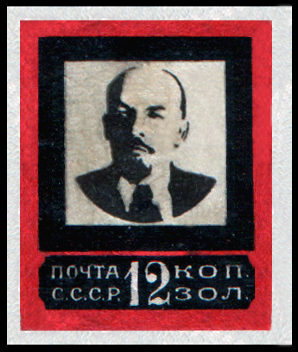
In philately, Leniniana is a topic for collecting postage stamps that tell about the life and story of Vladimir Lenin (1870–1924) or people, places, etc. connected with him. The topic was common in the Soviet Union.
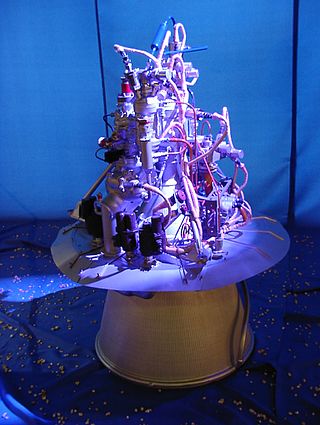
The RD-0109 is a rocket engine burning liquid oxygen and kerosene in a gas generator combustion cycle. It has single nozzle and is an evolution of the RD-0105. It was the engine used on the Vostok Block-E that launched Yuri Gagarin to orbit.
